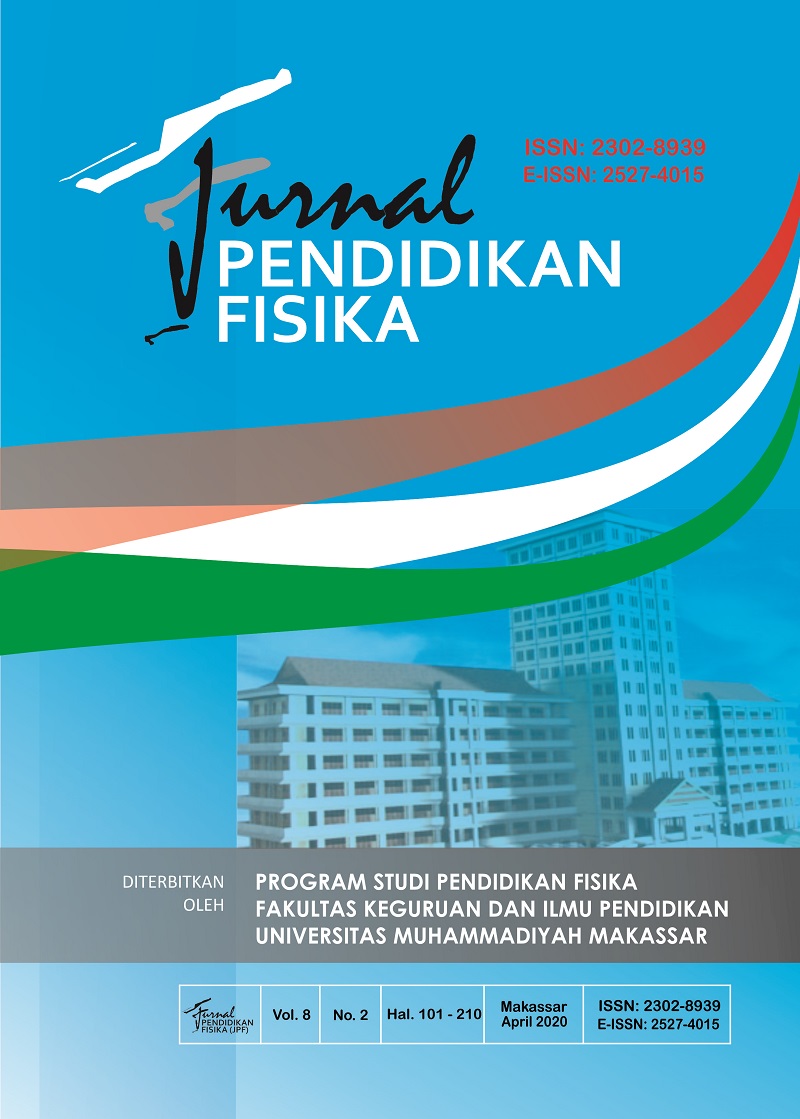Cognitive Competencies Achievement in Application and Analysis Levels for the Topic of Newton Laws at UNTAD Labschool High School
DOI:
https://doi.org/10.26618/jpf.v8i2.3204Keywords:
Cognitive Competency, Application Level, and Level AnalysisAbstract
This study aims to analyze the evaluation in Labschool UNTAD High School Palu. Research data obtained through essay tests and interviews. The cognitive competency test consists of 6 items that were discussed by interviewing 6 selected respondents. Analysis of research data using descriptive-qualitative research. The results showed that this study reached 61.10% or in the very poor category and the level of analysis only reached 25.92% or in the very poor category. Comprehensive analysis application. Better than analysis. From the results obtained can be obtained from students who are able to solve problems, applications that cannot solve problems, category analysis. ointment students, forget, there is no preparation before the exam, less maximum learning in class and no interest in physics.
References
L. W. Anderson., dan D. R Krathwohl, A Taxonomy For Learning, Teaching, and Assesing; A Revision of Bloom’s Taxonomy of Education Objectives. New York: Addison Wesley Lonman Inc., 2001.
A. K. Sulistyorini, Pujayanto, and E. Y. Ekawati, Jurnal pendidikan fisika. Vol. 1 (1), 2013, pp. 19-26.
S. Arikunto, (2009), Dasar-Dasar Evaluasi Pendidkan. Jakarta: Bumi Aksara.
Setyowibowo, Jurnal Pendidikan Matematika dan Sains, Vol. 3, 2019.
R. Afriani, Analisis Pencapaian Kompetesi Kognitif Tingkat Analisis (C4) pada siswa Kelas XI Negeri di Kota Palu. Skipsi Fakultas Keguruan dan Ilmu Pendidikan Universitas Tadulako, Palu, 2017.
Muslimin, M.Y. Hidayat, and S. Anggereni, Jurnal Pendidikan Fisika Vol 6 (2), 2018, pp. 96-101.
Sulistyorini, A.K., Pujayanto dan Ekawat, E.Y., Jurnal Pendidikan Fisika, Vol.1(1), 2013, pp. 1-6.
Ramos, J.L,S., Dolipas, B.B, and Villamor, B.B., International Journal of Innovative Interdisciplinary Research, Vol. 4, 2013.
Saido, M.G., Siraj, S., Bin Nordin, A.B., Omed Saadallah Al_Amedy, and O.S., MOJES .The Malaysian Online Journal of Educational Science, Vol. 3(3), 2015.
R. Mc Bain, A Studi of Student Cognitive Levels Using Blooms Taxanomy, Publication Date Sept 2011.https://files.eric.ed.gov/fulltext/ED524386.pdf
Kul, Ü., Sevimli, E., & Aksu, Z. TURJE Turkish Journal of Education, Vol. 7 (3), 2018, pp. 136-155.
Burçin, G., Usta N., and Demir, Ö., Journal of Cognitive and Education Research, Vol. 1(1), 2015, pp. 50-70.
E. Bozkurt, Asia-Pacific Forum on Science Learning and Teaching, Vol. 15 (2), Article 5, 2014, pp.1.
S. R. Yuliati and I. Lestari, Higher Order Thinking Skill Analysis of Student in Solving HOTS Question in Higher Education, PERSPEKTIF Ilmu Pendidikan Vol. 32 ( 20), pp. 2018 181.
Alias, S.N., dan Ibrahim, F., International Journal of Multicultural and Multireligious Understanding, Vol. 3(3), 2016, pp. 1-5.
Downloads
Additional Files
Published
Issue
Section
License
Copyright:
Authors who publish with this journal agree to the following terms:
1. Authors retain copyright and grant the journal right of first publication with the work simultaneously licensed under a Creative Commons Attribution-ShareAlike 4.0 International License that allows others to share the work with an acknowledgement of the work's authorship and initial publication in this journal.
2. Authors are able to enter into separate, additional contractual arrangements for the non-exclusive distribution of the journal's published version of the work (e.g., post it to an institutional repository or publish it in a book), with an acknowledgement of its initial publication in this journal.
3. Authors are permitted and encouraged to post their work online (e.g., in institutional repositories or on their website) prior to and during the submission process, as it can lead to productive exchanges, as well as earlier and greater citation of published work.
Licence:
Authors are free to:
1. Share: Copy and redistribute the material in any medium or format
2. Adapt: Remix, transform, and build upon the material for any purpose, even commercially.
The licensor cannot revoke these freedoms as long as the authors follow the license terms, which include the following:
1. Attribution: You must give appropriate credit, provide a link to the license, and indicate if changes were made. You may do so in any reasonable manner, but not in any way that suggests the licensor endorses you or your use.
2. ShareAlike: If you remix, transform, or build upon the material, you must distribute your contributions under the same license as the original.
3. No additional restrictions: You may not apply legal terms or technological measures that legally restrict others from doing anything the license permits.
Jurnal Pendidikan Fisika is licensed under a Creative Commons Attribution-ShareAlike 4.0 International License.

